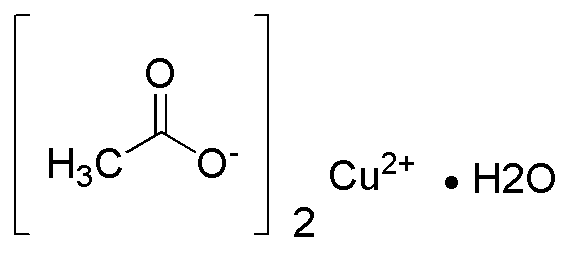Copper(II) acetate monohydrate is widely utilized in research focused on:
- Catalysis: This compound serves as a catalyst in various organic reactions, enhancing reaction rates and improving yields, particularly in the synthesis of fine chemicals.
- Textile Industry: It is used as a mordant in dyeing processes, helping to fix dyes onto fabrics, which results in vibrant and long-lasting colors.
- Electroplating: In the electroplating industry, it acts as a source of copper ions, facilitating the deposition of copper onto surfaces for improved conductivity and corrosion resistance.
- Biological Research: Researchers utilize it in studies related to enzyme activity and biochemical pathways, as it can influence the behavior of certain biological molecules.
- Wood Preservation: This compound is employed in the formulation of wood preservatives, providing protection against fungal decay and insect damage, thus extending the life of wooden structures.
General Information
Properties
Safety and Regulations
Applications
Copper(II) acetate monohydrate is widely utilized in research focused on:
- Catalysis: This compound serves as a catalyst in various organic reactions, enhancing reaction rates and improving yields, particularly in the synthesis of fine chemicals.
- Textile Industry: It is used as a mordant in dyeing processes, helping to fix dyes onto fabrics, which results in vibrant and long-lasting colors.
- Electroplating: In the electroplating industry, it acts as a source of copper ions, facilitating the deposition of copper onto surfaces for improved conductivity and corrosion resistance.
- Biological Research: Researchers utilize it in studies related to enzyme activity and biochemical pathways, as it can influence the behavior of certain biological molecules.
- Wood Preservation: This compound is employed in the formulation of wood preservatives, providing protection against fungal decay and insect damage, thus extending the life of wooden structures.
Documents
Safety Data Sheets (SDS)
The SDS provides comprehensive safety information on handling, storage, and disposal of the product.
Product Specification (PS)
The PS provides a comprehensive breakdown of the product’s properties, including chemical composition, physical state, purity, and storage requirements. It also details acceptable quality ranges and the product's intended applications.
Certificates of Analysis (COA)
Search for Certificates of Analysis (COA) by entering the products Lot Number. Lot and Batch Numbers can be found on a product’s label following the words ‘Lot’ or ‘Batch’.
*Catalog Number
*Lot Number
Certificates Of Origin (COO)
This COO confirms the country where the product was manufactured, and also details the materials and components used in it and whether it is derived from natural, synthetic, or other specific sources. This certificate may be required for customs, trade, and regulatory compliance.
*Catalog Number
*Lot Number
Safety Data Sheets (SDS)
The SDS provides comprehensive safety information on handling, storage, and disposal of the product.
DownloadProduct Specification (PS)
The PS provides a comprehensive breakdown of the product’s properties, including chemical composition, physical state, purity, and storage requirements. It also details acceptable quality ranges and the product's intended applications.
DownloadCertificates of Analysis (COA)
Search for Certificates of Analysis (COA) by entering the products Lot Number. Lot and Batch Numbers can be found on a product’s label following the words ‘Lot’ or ‘Batch’.
*Catalog Number
*Lot Number
Certificates Of Origin (COO)
This COO confirms the country where the product was manufactured, and also details the materials and components used in it and whether it is derived from natural, synthetic, or other specific sources. This certificate may be required for customs, trade, and regulatory compliance.


